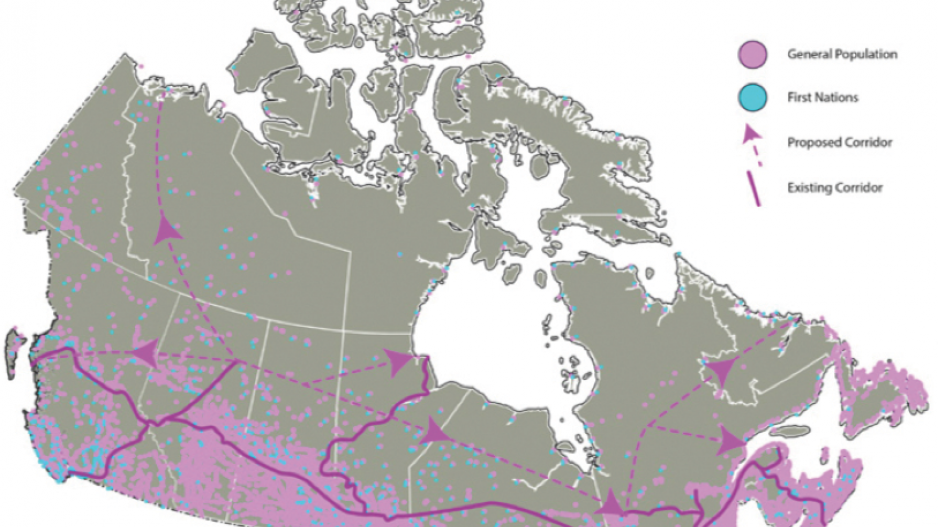China has its $900 billion Belt and Road Initiative; Saudi Arabia has its $500 billion Neom megacity project.
So what does Canada have in the way of a new nation-building exercise?
It’s called the Northern Corridor – an ambitious $100 billion plan to connect Canada’s far and near north to the rest of the country with a 7,000-kilometre multi-modal right-of-way that would blaze a path for new roads, railway lines, pipelines, power transmission lines and telecommunications.
More than just an infrastructure project, however, it is being described as a potential starting point for a new era of reconciliation with First Nations, because it could not be built without their consent and participation.
According to a feasibility study published by the University of Calgary’s School of Public Policy, each link would end at tidewater: Prince Rupert, Churchill (Hudson Bay), Mackenzie River basin (Northwest Territories), the Saint Lawrence Seaway and northern Labrador. An idea that has been around for decades, the Northern Corridor got support this summer from the Senate Standing Committee on Banking, Trade and Commerce, which recommended the federal government earmark $5 million for further study.
It also recommended that two of the six proposed links should be given priority: the B.C. link, which would connect northern Alberta to Prince Rupert, and a new right-of-way connecting northern Saskatchewan and Manitoba’s Port of Churchill.
“The most critical access in the short term would be to the West Coast and the Hudson Bay because of their proximity to growing and increasingly open Asian and European markets,” the committee recommends.
The Northern Corridor would bring infrastructure to northern and First Nations communities and ease pressure on the major ports of Vancouver and Eastern Canada by providing more tidewater access to foreign markets for Canada’s major exports: grain, lumber, minerals and oil and gas.
“If you look back through the economic history of Canada, when it comes to transportation, we’re in some ways economically a country that’s built on these big infrastructure projects,” said study co-author Garret Kent Fellows.
He pointed to projects like the Canadian Pacific Railway, the Saint Lawrence Seaway and Trans-Canada Highway as examples. The proposal would require senior government investments in the negotiation of the rights-of-way and the building of public roads and utilities, with other infrastructure – pipelines and railways, for example – built by the private sector. Canada has been busy negotiating free trade agreements with the European Union, South Korea and other trading partners. But Fellows said Canadian ports, like Vancouver’s, are already becoming congested. Currently, almost half of all exports in Canada (48%) move through B.C. ports.
“Those free trade agreements are great, but if we don’t have the physical capacity to get our goods to those markets, you’re really not going to capitalize on this negotiation work that we’re doing to secure the free trade agreements. The Port of Metro Vancouver is a very important port to Canada, but it’s also a port that’s running out of land. If you’re looking to expand that port, it’s really hard to do it. Further up the coast, Prince Rupert, you don’t have that problem.” (See “Pinpointing B.C. Port Priorities,” pages 6–7.)
Should the federal government approve the Senate committee’s recommendations, it would earmark $5 million for a more detailed series of studies by the School of Public Policy and Quebec’s Center for Interuniversity Research and Analysis of Organizations. These studies would address issues like the environmental and engineering challenges of building new roads and railways on permafrost. The recent failure of multibillion-dollar oil and liquefied natural gas projects in B.C. highlight how difficult it can be to build greenfield transmission projects in Canada. Such projects might be easier to get approval for if they followed a right-of-way established by senior government – a process that would deal with environmental and First Nation issues up front.
“In our scoping study, we stress the idea of a multi-modal right-of-way,” Fellows said. “So you establish your right-of-way, you do all your negotiations ahead of time, and then we sort of have this idea of where the backbone will be, when we get to the point where either you’ve got public funds to fund infrastructure or, in some cases, private projects, like a rail line.”
Negotiating such a right-of-way could be done as part of a broader First Nation reconciliation exercise. First Nations have argued that the current environmental review process for projects like pipelines focuses only on project-specific impacts and does not properly consider cumulative impacts. Establishing new rights-of-way could address some of those concerns.
“They’ve got claims to a lot of land,” said Sen. Dave Tkachuk, who chairs the Senate standing committee. “Why don’t we just solve this problem and say, ‘Well, let’s be partners through all of this?’”
The B.C.-based First Nations Major Projects Coalition (FNMPC), which includes members from 37 B.C. First Nations, has taken no position on the Northern Corridor, but told the Senate committee earlier this year that the project would need to involve First Nations from the outset.
“The message that [First Nations have] said loud and clear in the last couple of years is ‘Involve us right from the beginning,’” Corrina Leween, chief of the Cheslatta Carrier Nation, told Business in Vancouver. “Maybe this is a good thing for the economy of the people that live there. At the same time, maybe it is not a good idea.”




